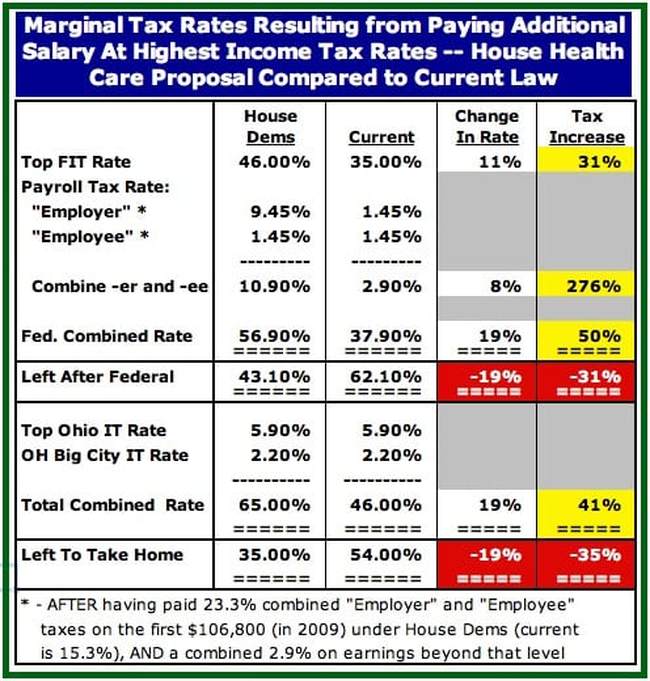Imagine, if you can — and given the likely results if cap-and-trade legislation recently passed by the House ever makes it into law, you don’t have to imagine very hard — that after paying $500 a month for utilities, your household is slapped with an increase that will cause your monthly bills to go up to $750.
How much have your costs increased? That’s obviously not a trick question; the answer is 50%.
But that’s not the language of taxation. That needs to change.
The current government spin applied to the above situation would go something like this: “Well, since your income is $5,000 per month, and your utility bills are increasing from 10% of your income ($500 divided by $5,000) to 15% of your income ($750 divided by $5,000), your utility rate is only going up 5% (15% minus 10%).”
If your neighbor tried to console you with such language and said, “What’s the big problem here?,” you’d be tempted to deck him or even her (but being a sensible person, you’d resist) — especially because (and I’ll get to this later) such an increase would force you to cut your discretionary spending by way more than 5%. Yet we let politicians get away with taxation verbiage like this all the time. This serves to make their seemingly endless designs on the contents of our wallets appear more palatable than they should.
The last time I recall a real pushback against this mathematical chicanery was in Ohio during the early 1980s. Helped along by political clumsiness, the blowback was effective enough that it should have been considered a model for future anti-tax efforts. Instead, it has mostly fallen into the dustbin of history.
But to measure the tactic’s effectiveness, all you have to do is ask almost any news-following longtime Buckeye State resident older than 50, “Who raised Ohio’s income tax by 90%?” The overwhelming odds are that they will answer, “Oh, that was Dick Celeste.”
Now, of course, Celeste didn’t take 90% of Ohioans’ income (though, given his far-left political positions, he may at some point have been tempted). Also, nobody ever said he was the brightest tactician. In 1983, shortly after winning office, Celeste, with the help of a slim majority of Democrats in the Ohio Senate, imposed a “temporary tax rate surcharge [that was] increased to 83.3% in 1983 and to 90% in 1984 and made permanent.”
Celeste and the Democrats protested that 50% of that 90% was “only” a continuation of a “temporary” tax passed by the previous administration, and that the other 40% was “only” a rate hike of a couple of percentage points.
The complaints fell flat. Everyone in the state knew that what the Democrats had imposed was a permanent tax increase of 90%. Because it was applied across the board to all rate brackets (that was the clumsiness, partially inherited from clumsy Republicans), even those who supported it had a hard time not speaking of the truly correct 90% increase.
William Hershey of the Dayton Daily News, who seems more than a little bitter, recalled last month that:
Democrats controlled the Senate by just one vote, 17-16. All 17 voted for Democratic Gov. Dick Celeste’s so-called “90 percent tax hike” — a renewal of a temporary income tax increase plus an increase. None of the Republicans voted for it.
Senate Republicans used the tax issue to grab control of the Senate in the 1984 elections and have maintained that majority for 25 years. The way the Republicans told the story, every Democratic senator who voted for the tax increase and was up for re-election cast the 17th and decisive vote.
“It destroyed us,” [former Senate Democratic leader Harry] Meshel recalled.
The tax changes proposed by Congress to fund its statist designs on health care represent a clarion call to resurrect the just-described language.
Though the draft bill has been released, it’s clear that the legislation will go through the usual sausage grinding. So for simplicity’s sake, I’m going to use these core elements of what House leaders want as the Wall Street Journal understood them on Monday:
- An 8% payroll tax surcharge (you read that right), “that would apply to all firms with 25 or more workers that don’t offer health insurance to their employees.”
- If nothing is done about them and the president sticks to his oft-repeated campaign promise: increasing federal income tax rates to their level before the Bush tax cuts of 2001 and 2003 for those earning above about $250,000.
- Beyond said restoration, an income tax surcharge of up to 5.4%.
Since the tax-and-spenders are more clever, it’s not easy to frame these rate increases as tax increases. But it can be done — and I will do it.
Let’s take someone who would be subject to all of the taxes noted above; there are plenty of small businesses whose owners pay themselves well but who, for various reasons (which, frankly, should be none of our business), don’t offer their employees health insurance. Using rates currently in effect and the proposed rates as calculated by the Journal, this would be the before-and-after picture for such business owners in Ohio who are considering withdrawing additional salary:

Now you see how really devastating the House’s proposal is:
- The tax increase isn’t the rate change of 11%; it’s the increase in the rate, which is 31%. The House surtax proposal and the return to the rates in effect before Bush’s tax cuts will cause affected persons to pay $46 out of every $100 they try to pay themselves. That’s 31% more and it’s not arguable.
- Properly stated, the marginal payroll rate the affected persons will pay, which would increase from 2.9% to 10.9%, represents a whopping, inarguable 276% tax increase.
- The affected persons’ marginal federal tax rate will increase by 50%. Beyond that, out of every additional $100 paid, they will only get to keep $43.10 instead of $62.10. Thus, they will have 31% less with which to pay state and city income taxes (coming up), other taxes not listed such as property taxes, and their personal and family bills.
- When combined with Ohio’s already-existing state and municipal income taxes (the big-city rate is the average found in Ohio’s largest cities), the affected person’s marginal rate goes from its current 46% to a truly confiscatory 65%. That’s a 41% tax increase. At that level, it leaves affected persons with a stunning 35% less money to pay other taxes not listed and their personal and family bills.
In sum, Congress wants to make a very small percentage of people pay roughly 50% more to the federal government than they do currently and, depending on their state of residence, to take about one-third of what they currently live on — all to fund other people’s health care.
Now that is an opposition message that would, I believe, go a long way towards stopping this utter nonsense dead in its tracks.









Join the conversation as a VIP Member